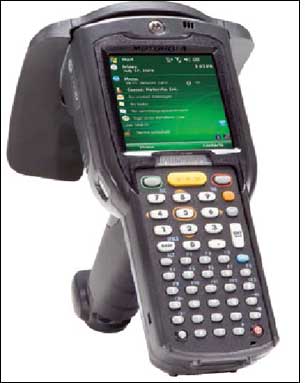Motorola today unveiled the MC3090-Z, a handheld RFID reader designed for non-industrial uses, such as tracking products in retail shops, assets in IT or health-care centers, or documents within an office environment. Weighing 22.93 ounces (650 grams), battery included, the device is significantly lighter than the company’s other handheld RFID readers, says Chris Schaefer, Motorola’s director of product marketing. The MC3090-Z also features a new antenna design optimized for reading RFID tags within a 3- to 9-foot area around the reader.
In addition, the MC3090-Z supports a feature that will enable users to determine the locations of specific RFID tags. The function will direct users to the desired tag through both visual cues (on the reader’s display screen) and audible cues. Motorola plans to make this functionality available in spring 2010, Schaefer says.
EPCglobal has certified that the reader is compliant with the ultrahigh-frequency (UHF) passive EPC Gen 2 standard (ISO 18000-C) for reading and encoding passive tags. The device supports the low-level reader protocol (LLRP) for linking readers from a variety of manufacturers, but not the application level events (ALE) standard, which directs how EPC data is collected and filtered. The MC3090-Z contains a 3-inch color touch-screen LCD display, a 48-key alphanumeric keypad and a scanner for reading 1-D bar codes. It runs Microsoft‘s Windows Mobile 6.1 operating system, and for connecting to a user’s wireless LAN, the device contains a radio compliant with the IEEE 802.11a/b/g standard
Many retailers currently use the MC9090-G RFID interrogator, or some other Motorola handheld reader that is designed for use in industrial areas, such as warehouses or distribution centers, and is thus made to survive extreme temperatures and environmental conditions—for instance, shock from a long fall to a concrete floor. In providing feedback, such users requested a more lightweight, nimble device, Schaefer says, “meant for use in the carpeted space, where an industrial product is overkill.”
“It’s about having a device that fits into where people work,” Schaefer states.
Motorola recently patented the antenna used in the MC3090-Z reader. The antenna is omnidirectional, thus enabling data capture regardless of a tag’s orientation to the reader—a feature especially important for retail applications, wherein tags are affixed to items at a variety of positions and places, based on the type of item. The antenna design also creates a wide read zone around the interrogator, which makes it well suited, for example, to reading tags attached to apparel hung on racks as an employee walks down a central aisle. The MC9090-G, by way of comparison, has a directional antenna that creates a conical read zone, emanating from the nose of the reader gun.
In shedding weight, the MC3090-Z also lost some of the ruggedness enjoyed by handhelds used for industrial applications. However, Motorola notes, the new reader can still pass stringent impact tests. The device can survive a 4-foot drop to concrete, and can operate in temperatures ranging from 14 degrees Fahrenheit to 122 degrees Fahrenheit (-10 degrees Celsius to 50 degrees Celsius). It is also sealed in order to withstand dusty environments, spilled liquids and routine cleaning.
A version of the MC3090-Z that operates in the 902-928 MHz range for use in the United States and Canada will be available on Jan. 24, 2010, at a suggested retail price of $3,395. A European version, which will operate at 865.7 to 867.5 MHz, is expected to be available some time next year, at the same cost.


